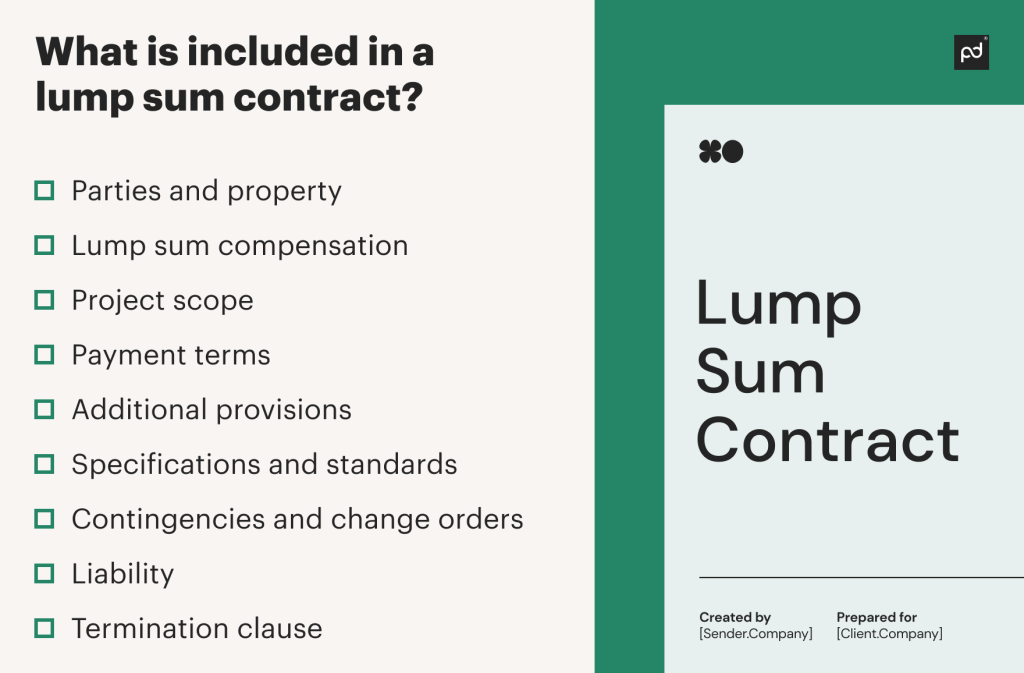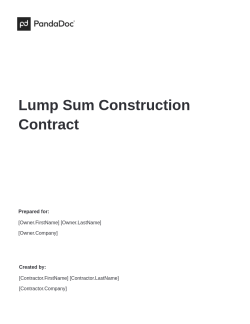Several types of construction contracts make the world go round, and the overwhelming majority of these are what’s known as lump sum contracts.
In this article, we’ll explain everything you need to know about lump sum contracts and if they’re right for you.
Key takeaways
- Lump sum contracts are simple and convenient for many building projects.
- Smaller jobs or well-defined projects are best suited to lump sum construction contracts.
- There can be risks to both the owner and the contractor so make sure to lay out project scope and requirements as clearly as possible.
- Document workflow software like PandaDoc makes it a breeze to manage construction contracts.
What is a lump sum contract?
A lump sum contract is an agreement to provide a project with a set price.
A lump sum agreement is one of several types of business contracts, and may also be referred to as a stipulated sum or fixed price agreement.
It’s primarily used in the construction business.
Let’s go into more depth. Two parties enter an agreement with a set fee.
The owner of the contract agrees to pay the contractor the agreed-upon price.
The ‘lump sum’ refers to this total price, not the payment schedule – owners will usually pay in regular installments.
The contractor agrees to deliver the full scope of the project at that price regardless of incurred costs.
Lump sum contracts offer a convenient way for builders to bid for jobs. They also provide owners with accurate costs for budget allocation and financing.
What is included in a lump sum contract?

A lump sum contract doesn’t need as many details as other construction contracts.
However, like any contract for services, lump sums need clauses for terms such as scope and timeline.
Here are the sections to include in your lump sum construction contract:
- Parties and property: Details of the owner, contractor, and the development property.
- Lump sum compensation: The amount the owner agrees to pay the contractor. You can only adjust the sum through change orders.
- Project scope: Project details must be clearly defined. This includes material usage and labor provisions, though they will likely be estimates rather than finalized details.
- Payment terms: Outline the cost breakdown and payment schedule. It is typical to spread payments out equally over time. The owner may wish to include conditions to hold back a portion of each payment as retainage. The owner pays the retainage out upon project completion.
- Additional provisions: Outline terms for permits, permissions, hazards, inspections, and other provisions.
- Specifications and standards: Define architectural design and other building specifications. Additionally, any compliance requirements or standards must be set out for the project.
- Contingencies and change orders: Include contingencies for unforeseen circumstances and disruption. Outline terms for creating and negotiating change orders when altering the agreement.
- Liability: Define the liabilities of each party and insurance requirements for both parties.
- Termination clause: Agreed-upon circumstances for which either party can terminate the contract.
When to use a lump sum contract
Lump sum contracts work best with a defined scope and timeline.
That means small and medium projects – for instance, a house owner adding an extension having already secured planning permission – are great candidates.
However, many larger projects and government contracts are initiated without a final plan.
The owners of these construction projects want to get things going right away. They aim to fully flesh out the finished specifications while building work is underway.
These projects are better suited to other construction contract types as estimating the cost is harder.
You can start today by downloading a free lump sum contract template from PandaDoc.

Lump Sum Construction Contract
Used 4873 times
If you’re in the midst of a construction project and need to get a contractor on board at a set fee, then you need this lump sum construction contract.
Use this templateThe advantages of a lump sum contract
There are many lump sum contract advantages and disadvantages. Let’s start with the good stuff.
Simplicity
Among all the available construction contracts, the lump sum contract is the easiest to follow. The price and terms are set out.
There isn’t much room for flexibility other than change orders, which can be rejected. Each party understands what they are liable for and what to expect.
Easier to finance
It is often easier for you to secure financing for lump sum construction contracts.
Lenders are more confident that project specifications and costs are already finalized.
There is less risk a project won’t bring them a return.
Additionally, it means the owner won’t need additional financing should construction costs exceed the budget.
Less risk for owners
Locking in costs upfront means less risk for owners. Any agreed-upon contract will fit within budget regardless of the actual final costs of the project.
Project owners know they will not need to allocate extra funds for construction (though they should keep some available for possible changes during the project itself).
Higher potential profits
On the contractor side of things, a lump sum gives a clear target for project costs and revenue.
The contractor can cut costs with cheaper materials and a more efficient process during the building.
Any cost savings translate directly to contractor profits.
Contractors keep this in mind when they bid for a lump sum contract – and as we’ll see in disadvantages, owners should, too.
Less oversight and administration
Lump sum building contracts don’t create the extra workflows of admin-heavy agreements, like cost-plus contracts.
Paperwork such as invoices, approvals, and payment forms can make you feel stuck in the mud.
With everything agreed upon initially, both parties can work autonomously and efficiently.
The disadvantages of a lump sum contract
As mentioned earlier, these contracts aren’t suitable for every situation.
Here are some lump sum contract risks to consider:
Higher costs for the owner
A contractor prepares a lump sum contract bid while estimating costs and contingencies. They then add their expected profit margin to the total.
It is only an estimate, and there are two ways this can disadvantage the owner:
- If the owner is unfamiliar with construction, it’s easy to accept an estimate higher than needed
- If things are done more quickly than planned, the owner may pay more than they would with a cost-plus contract.
Poorer build quality
One of the inherent flaws of the lump sum contract is that it incentivizes corner-cutting.
Contractors may be monetarily motivated to reduce spending across the board.
This can result in cheaper, inadequate materials and less skilled labor to increase profits.
Less flexibility
Construction projects don’t always go as planned. Many contract variations may occur such as:
- Design errors
- Omissions and discrepancies
- Changes in local jurisdiction or compliance
- Specification changes
- Changes in material due to need or supply chain issues
Changes like these are difficult to deal with under a lump sum contract. To address an issue, both parties must negotiate a change order.
Contract negotiations are a lengthy process that involves plenty of paperwork and legal advice.
More risk for the contractor
Lump sum bids only work for contractors if they can come up with a reasonably accurate estimate.
The bidding process requires the right time and tools to get the cost breakdown right.
If the contractor underestimates the project’s cost, they will lose profits.
If there are delays or supply chain issues after the contract is signed, they’ll also be at a loss.
Lump sum contract example
You might know how to draft a contract, but how does a lump sum project work?
Let’s take a look at an example.
- The owner spends adequate resources developing a project for a new office remodel. The project team clearly defines the scope, timeline, and specifications.
- The owner puts out a call to contractors for a specific construction project.
- A contractor takes the project information and comes up with a cost estimate. They base the estimate on materials, subcontractors, labor costs, contingencies, timelines, and profit margins.
- The contractor uses this amount to make a lump sum contract bid with the owner.
- The proposed bid and cost breakdown satisfies the project owner. They sign the construction contract.
- The building contractor initiates construction by hiring subcontractors and laborers. The project is to take five weeks. The owner agrees to pay one-fifth of the lump sum every week until completion.
- During construction, a subcontractor doesn’t show up to fit the air conditioning. The contractors find a more expensive replacement at short notice to keep the project on schedule.
- During the 4th week, it turns out that the specified windows don’t meet building regulations. To be able to progress, the contractor writes out a change order.
- The owner receives the change order and evaluates it. They negotiate a new price that covers the cost of the necessary building materials.
- Building completed on time. The owner pays the contractor the newly agreed-upon amount to satisfy the cost breakdown of the contract.
Choose the most suitable contract with PandaDoc
Lump sum contracts are among the most simple agreements used in construction. However, that doesn’t mean there isn’t plenty of work involved!
Every contract must contain a comprehensive set of terms and conditions to protect each party.
You could spend your resources on legal paperwork whenever you have a project or bid for a contract.
Who doesn’t love diving head-first into legalese daily?
We offer a better alternative.
Use PandaDoc contract management software to handle all of your construction agreements.
Our software gives you a centralized space to easily edit and sign your contracts and streamline your document workflows with native CRM integrations.
We also provide templates and e-Signature options to speed up approvals and agreements so you can get to work.
Frequently asked questions
-
The four types of construction contracts are lump sum contracts, cost plus contracts, unit price contracts, and time and materials contracts. Lump sum contracts are based on a final cost breakdown. In cost plus contracts, owners pay expenses plus an agreed-upon amount or percentage.
Unit price contracts use measurable units such as square meters for cost. Lastly, time and materials contracts outline a daily or hourly rate for builders on top of other project-related costs.
-
A GMP contract outlines a maximum cost for a project. Even if the builder exceeds budget, the owner will not be obligated to pay above the price. However, the project owner pays less than the GMP if the cost threshold isn’t reached.
A lump sum contract is not based on the final cost of a project. The owner pays the amount regardless of whether the contractor spends more or less than estimated to complete the project.
-
Cost plus contracts guarantee a profit margin for builders. The owner covers All project costs with a tacked-on fee for materials and labor. This contract type is excellent for the contractor. However, the owner is at risk of going over budget.
Lump sum contracts don’t account for the actual costs of a construction project. The payment fee is set at the beginning. The contractor is not guaranteed a set profit amount. However, they can increase profitability through efficient materials and labor.
-
A time and materials contract defines an hourly or day rate for builders. The project owner must also pay for materials and other overhead costs. A project that takes longer than expected dramatically increases the final cost.
The owner doesn’t need to worry about an increased cost with lump sum contracts. No matter how long the contractor takes to complete the project, the total cost remains the same.
-
Unit price contracts base fees on the material and labor costs of completing a task. The “units” can be anything from square feet for carpeting to miles of road. There is no agreed-upon final price. The total amount is only known when the builder completes the project.
Lump sum contracts are not affected by how many units it takes to finish a project. If it takes less or more than expected, the contractor receives the same payment.
Disclaimer
PandaDoc is not a law firm, or a substitute for an attorney or law firm. This page is not intended to and does not provide legal advice. Should you have legal questions on the validity of e-signatures or digital signatures and the enforceability thereof, please consult with an attorney or law firm. Use of PandaDoc services are governed by our Terms of Use and Privacy Policy.


